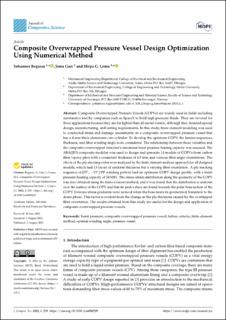| dc.contributor.author | Regassa, Yohannes | |
| dc.contributor.author | Gari, Jema | |
| dc.contributor.author | Lemu, Hirpa Gelgele | |
| dc.date.accessioned | 2022-08-18T08:29:27Z | |
| dc.date.available | 2022-08-18T08:29:27Z | |
| dc.date.created | 2022-08-17T13:57:46Z | |
| dc.date.issued | 2022-08-05 | |
| dc.identifier.citation | Regassa, Y., Gari, J., & Lemu, H. G. (2022). Composite Overwrapped Pressure Vessel Design Optimization Using Numerical Method. Journal of Composites Science, 6(8), 229. | en_US |
| dc.identifier.issn | 2504-477X | |
| dc.identifier.uri | https://hdl.handle.net/11250/3012506 | |
| dc.description.abstract | Composite Overwrapped Pressure Vessels (COPVs) are widely used in fields including aeronautics and by companies such as SpaceX to hold high pressure fluids. They are favored for these applications because they are far lighter than all-metal vessels, although they demand special design, manufacturing, and testing requirements. In this study, finite element modeling was used to conducted stress and damage assessments on a composite overwrapped pressure vessel that has a 4 mm thick aluminum core cylinder. To develop the optimum COPV, the lamina sequences, thickness, and fiber winding angle were considered. The relationship between these variables and the composite-overwrapped structure’s maximum burst pressure bearing capacity was assessed. The ABAQUS composite modeler was used to design and generate 14 models of COPVs from carbon fiber/epoxy plies with a consistent thickness of 6.5 mm and various fiber angle orientations. The effects of the ply stacking order were analyzed by the finite element analysis approach for all designed models, which had 13 layers of uniform thickness but a varying fiber orientation. A ply stacking sequence of [55◦, −55◦] PP winding pattern had an optimum COPV design profile, with a burst pressure bearing capacity of 24 MPa. The stress–strain distribution along the geometry of the COPV was also obtained using the finite element method, and it was found that the distribution is uniform over the surface of the COPV and that its peak values are found towards the polar boss section of the COPV. Extreme stress gradients were noticed when the boss nears its geometrical transition to the dome phase. This factor is evident from the change in the ply thickness caused by the overlapped fiber orientation. The results obtained from this study are useful for the design and application of composite overwrapped pressure vessels. | en_US |
| dc.language.iso | eng | en_US |
| dc.publisher | MDPI | en_US |
| dc.rights | Navngivelse 4.0 Internasjonal | * |
| dc.rights.uri | http://creativecommons.org/licenses/by/4.0/deed.no | * |
| dc.subject | burst pressure | en_US |
| dc.subject | composite overwrapped pressure vessel | en_US |
| dc.subject | failure criteria | en_US |
| dc.subject | finite element method | en_US |
| dc.subject | optimal winding angle | en_US |
| dc.subject | pressure vessel | en_US |
| dc.title | Composite Overwrapped Pressure Vessel Design Optimization Using Numerical Method | en_US |
| dc.type | Journal article | en_US |
| dc.type | Peer reviewed | en_US |
| dc.description.version | publishedVersion | en_US |
| dc.rights.holder | Copyright: © 2022 by the authors. | en_US |
| dc.subject.nsi | VDP::Technology: 500::Mechanical engineering: 570 | en_US |
| dc.subject.nsi | VDP::Technology: 500::Materials science and engineering: 520 | en_US |
| dc.source.pagenumber | 1-17 | en_US |
| dc.source.volume | 6 | en_US |
| dc.source.journal | Journal of Composites Science | en_US |
| dc.source.issue | 8 | en_US |
| dc.identifier.doi | https://doi.org/10.3390/jcs6080229 | |
| dc.identifier.cristin | 2043848 | |
| dc.source.articlenumber | 229 | en_US |
| cristin.ispublished | true | |
| cristin.fulltext | original | |
| cristin.qualitycode | 1 | |

